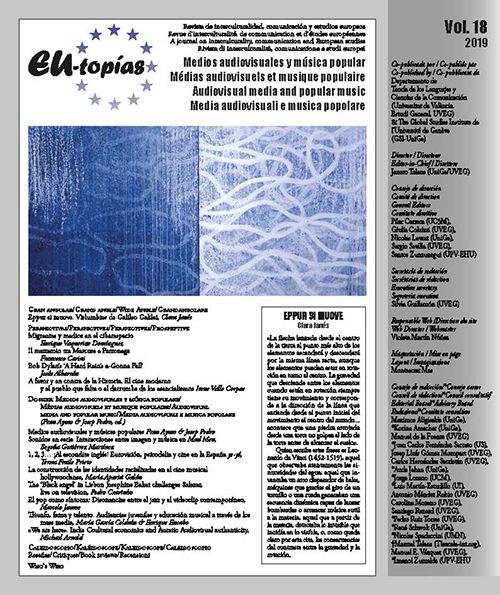Serial sounds. Interactions between image and music in Mad Men
DOI:
https://doi.org/10.7203/eutopias.18.16843Keywords:
Sound, music, seriality, image, Mad Men Abstract
Abstract
The television series Mad Men (Mathew Weiner, 2007-2015) is set in the 1960s in New York and deals mainly with the advertising universe. Its soundtrack contains both original and pre-existing pieces of music. Our goal is to analyze the interactions that are established between image and music in the first season of the series, employing textual analysis. We will examine its musical world, as well as the sensations that this world produces, in order to specify the experience of the spectators. To this aim, we will analyse different scenes from the first season where we can listen to characteristic musical themes of this audiovisual text. First, we will focus on the creative processes developed by composer David Carbonara and music supervisor Alexandra Patsavas, both responsible for Mad Men’s music. Secondly, we will analyze different scenes in which the following themes sound: “A Beautiful Mine» (RJD2, 2006); «Band of Gold» (Don Cherry, 1955); «On The Street Where You Live» (Vic Damone, 1956); «P.S. I Love You» (Bobby Vinton, 1967); «The Great Divide» (The Cardigans, 1996); «Água de beber» (Astrud Gilberto y Antonio Carlos Jobim, 1965); «Mad Men Suite» (David Carbonara, 2007); and «Don’t Think Twice, It’s All Right» (Bob Dylan, 1963). Finally, during the conclusions we will explain how music interacts with the following dimensions of the audiovisual text: formal elements of the series; audiovisual storytelling; historical accuracy.
 Downloads
Downloads
 References
References
Adorno, Theodor W. (1981), El cine y la música, Madrid: Fundamentos.
Anderson, Tim (2011), «Uneasy Listening: Music, Sound, and Criticizing Camelot in Mad Men», Gary R. Edgerton (ed.), Mad Men. Dream Come True TV, Londres y Nueva York: I.B. Tauris, págs. 72-85.
Carrión, Jorge (2011), Teleshakespeare, Madrid: Errata Naturae.
Cascajosa Virino, Concepción (2010), «Enmarcando Mad Men: elogio del contexto televisivo», Guía de Mad Men. Reyes de la Avenida Madison, Madrid: Capitán Swing, págs. 11-20.
Eguizábal Maza, Raúl (1998), Historia de la publicidad, Madrid: Eresma & Celeste Ediciones.
Freud, Sigmund (1987), «Lo siniestro», Freud, Sigmund, Obras Completas. Tomo VII (1916-1924), Biblioteca Nueva: Madrid, págs. 2483-2505.
García, Óscar (2014), «Álbum familiar del héroe americano», Vargas-Iglesias, Juan J. (coord.), Los héroes están muertos. Heroísmo y villanía en la televisión del nuevo milenio, Palma de Mallorca: Dolmen, págs. 135-143.
González Requena, Jesús (2001) «La Mujer, los Pájaros y las Palabras (The Birds, Hitchcock, 1963) », Trama y Fondo, 10, págs. 47-59.
González Requena, Jesús (2010), «Lo Real», Trama y Fondo, 29, págs. 7-28.
González Requena, Jesús (2016), Escenas fantasmáticas. Un diálogo secreto entre Alfred Hitchcock y Luis Buñuel, Granada: Centro José Herrero.
Jeffers McDonald, Tamar (2011), «Mad Men and the Career Woman: The Best of Everything?», Stoddart, Scott F. (ed.), Analyzing Mad Men. Critical Essays on the Television Series, Carolina del Norte: McFarland & Company, págs. 117-135.
Laplanche, Jean y Pontails, Jean-Bertrand (2004), Diccionario de Psicoanálisis, Buenos Aires: Paidós.
Lelane, Drake (2007), «Music on Mad Men: Classic Tunes Set The Scene For This Old Boys Club», MTV News, 25 de Julio de 2007 [http://www.mtv.com/news/2756402/music-on-mad-men-classic-tunes-set-the-scene-for-this-old-boys-club/, consultado el 06/06/2019].
Martin, Brett (2013), Hombres fuera de serie. De Los Soprano a The Wire y de Mad Men a Breaking Bad. Crónica de una revolución creativa, Barcelona: Ariel.
Moore, Frazier (2015), «‘Mad Men’ comes to its end», Gazette, 16 de mayo de 2015.
Navarro, Fernando (2015), «La radiografía sentimental de Mad Men a través de su música», El País, 16 de mayo de 2015 [https://elpais.com/cultura/2015/05/11/television/1431370711_632628.html, consultado el 06/06/19].
Starr, Michael (2012), «Stop the music! ‘Mad Men’ changes premiere», New York Post, 20 de marzo de 2012.
Sutcliffe, Tom (2009), «A schmooze transition», The independent, 1 de febrero de 2009.
Trakin, Roy (2006), «Alexandra Patsavas, Music Supervisor», AdAge, 15 de mayo de 2006 [https://adage.com/article/special-report-entertainment-marketers-of-the-year/alexandra-patsavas-music-supervisor/109170, consultado el 06/06/2019].
Vargas-Iglesias, Juan J. (2014), «Lo que está muerto no puede morir», Vargas-Iglesias, Juan J. (coord.), Los héroes están muertos. Heroísmo y villanía en la televisión del nuevo milenio, Palma de Mallorca: Dolmen, págs. 7-16.
Vázquez, Isabel (2015), Me llamo Peggy Olson. El retrato de una auténtica heroína entre los Mad Men, Barcelona: Series B.
Downloads
Published
How to Cite
-
Abstract314
-
PDF (Español)377
Issue
Section
License
![]()
The authors conserve the copyright. All content published in EU-topías. Journal of interculturality, Communication, and European Studies are subject to the license Creative Commons Attribution-NonCommercial-ShareAlike 4.0 license. The full text of the license can be found at <http://creativecommons.org/licenses/by-nc-sa/4.0>
They may be copied, used, disseminated, transmitted and publicly displayed, provided that:
- The authorship and original source of the publication is cited (journal, publisher and URL of the work).
- They are not used for commercial purposes.
- The existence and specifications of this license of use are mentioned.
It is the responsibility of the authors to obtain the necessary permissions for images that are subject to copyright.



